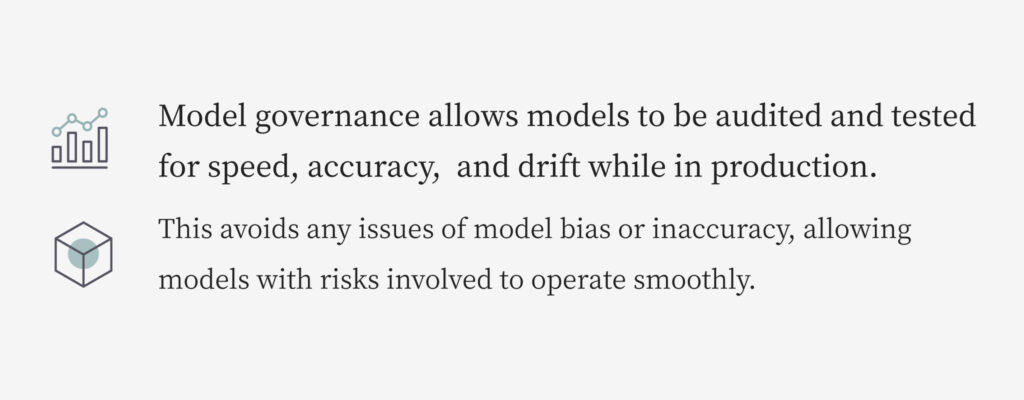- Blog
- AI for Practitioners
- What is Model Governance?
What is Model Governance?
This article was originally published at Algorithimia’s website. The company was acquired by DataRobot in 2021. This article may not be entirely up-to-date or refer to products and offerings no longer in existence.
AI/ML model governance is the overall process for how an organization controls access, implements policy, and tracks activity for models. Learn about model governance and how to implement it with our resources.
Machine learning projects can have a big impact on organizations, but they don’t always reach their full potential due to inefficiencies and disorganization in machine learning processes. Model governance is important for businesses and organizations to have in place in order to get the highest possible return on their machine learning investment.
Editor’s note: This blog post was last updated on October 18, 2021.
In this post, you’ll learn:
- What is model governance?
- Why is model governance important?
- Model governance use cases
- How Algorithmia helps with model governance
- Resources to learn more about model governance
- More from the AI/ML model governance blog series
What is Model Governance?
AI/ML model governance is the overall process for how an organization controls access, implements policy, and tracks activity for models and their results. Effective model governance is the bedrock for minimizing risk to both an organization’s bottom line and to its brand. Model governance is essential to minimize organizational model risk in the event of an audit, but includes a lot more than just regulatory compliance.
Complete and effective AI/ML model governance includes setting access controls for all models in production, versioning all models, creating the right documentation, monitoring models and their results, and implementing machine learning with existing IT policies.
Organizations that effectively implement all components of AI/ML model governance can achieve a fine-grained level of control and visibility into how models operate in production while unlocking operational efficiencies that help them achieve more with their AI investments. By tracking, documenting, monitoring, versioning, and controlling access to all models, these organizations can closely control model inputs and understand all the variables that might affect their results.
This level of visibility not only allows you to quickly identify and mitigate the potential risks of ML, such as introduced biases—but it also enables you to maximize the performance of your models in production. With the level of visibility that model governance enables, you can quickly spot issues that can degrade the performance of your models over time, such as model drift. In short, properly implemented model governance can help protect and enhance your business’ brand and bottom line.
Governance is especially crucial in models that have risk involved, such as models that manage financial portfolios. Since these models have a direct impact on the person or organization’s finances, it is extremely important to understand the inputs of a model and detect and correct any biases or incorrect learning within it.
Learn how to implement AI/ML model governance with our podcast, and continue reading to learn more about the topic.
Why is model governance important?
Since machine learning is a relatively new discipline, there are still many inefficiencies that need to be addressed with ML technology processes. Strong model governance and management solves many of these inefficiencies, which is why it is so important for organizations to implement. ML projects could be missing potential value without model governance in place.
The risk side of model governance is especially important, since it ensures that models involved with finances stay clear of dangerous risks. Since models are programmed to continue learning as they run, they can accidentally learn biases if they are presented with data that creates a bias, which can affect the decisions the model makes from that point on.
Model governance allows models to be audited and tested for speed, accuracy, and drift while in production. This avoids any issues of model bias or inaccuracy, allowing models with risks involved to operate smoothly.
A key benefit of model governance is its ability to clearly identify who has ownership of a model while a company changes over time. For example, if someone worked on a project years ago but has left the company, model governance helps keep track of projects, how they run, and where you left off.

Model governance use cases
To help you understand the importance of model governance, here are a few use cases.
As mentioned previously, the most glaring example of why model risk governance is important is in finance, but other industries need model governance as well. This section will walk through a few finance use cases, but then also address broadly model governance use cases in other industries as well.
The finance/banking industry uses machine learning models for many different processes that used to be done manually, such as credit scoring, interest rate risk modeling, derivatives pricing, and more.

Credit scoring
Overview – Credit scoring models help banks make informed decisions in the loan approval process by providing predictive analysis information concerning the potential for loan default or delinquency. This helps the bank determine the model risk pricing they should use for the loan.
Problem – This type of model involves risk for both parties: The bank and the loan applicant. If the model shows bias toward the bank, then the loan applicant cannot get the money they deserve. Or worse, if the model shows bias toward the loan applicant, they may take out a loan they cannot afford, causing a loss for the bank and financial trouble for the loan recipient.
Solution – Model governance solves this problem by auditing the model while it’s in production to make sure no biases are involved. Credit scoring models are more accurate and reliable than manual credit scoring, as long as they are governed.
Interest rate risk modeling
Overview – Interest rate risk models monitor earnings exposure to a range of potential market conditions and rate changes in order to measure risk. The purpose of this type of model is to give an overview of the potential risks of the account it is monitoring.
Problem – This model is directly related to risk, since risk is the output. If the model inaccurately judges the account as low risk, the account owner may lose money or miss out on potential gains by keeping the account where it is. If the model inaccurately judges the account as high risk, the account holder may move their money to other accounts and lose money or miss out on potential gains.
Solution – Model governance ensures that the model achieves its intended purpose. It is one thing to train a model in the development stages and get great results, and another thing to continue getting great results over time while that model is in production. With model management after deployment, you can be sure the models perform accurately over time.
Derivatives pricing
Overview – Derivatives pricing models estimate the value of assets by providing a methodology for determining the value of both new products and complex products without market observations readily available. This helps banks and investors determine if a business is worth investing in or not.
Problem – Investment banking is largely done by assessing the value of a company’s assets to determine the current value of the company. If this type of model includes inaccuracies, banks and investors may invest in companies that aren’t profitable investments.
Solution – This model needs to be governed and managed well into production and continuously throughout its lifespan in order to ensure investments are made with accurate information.
Other industries
All industries need model governance. Finance models are the easiest to illustrate the return on investment of model governance, but every type of model will provide a greater return on investment for the firm if it has governance features implemented.
For example, a business may be using a machine learning model to provide them with information about their target audience. If this model is in production for a substantial period of time without being audited, it is likely to become biased over time and begin producing inaccurate results. This could cause the business to make marketing decisions based on incorrect information which would waste their money marketing to the wrong audience or marketing in the wrong way.
There is a model governance use case for every type of model, since all ML models require auditing and testing continuously after deployment.
Value-Driven AI
DataRobot is the leader in Value-Driven AI – a unique and collaborative approach to AI that combines our open AI platform, deep AI expertise and broad use-case implementation to improve how customers run, grow and optimize their business. The DataRobot AI Platform is the only complete AI lifecycle platform that interoperates with your existing investments in data, applications and business processes, and can be deployed on-prem or in any cloud environment. DataRobot and our partners have a decade of world-class AI expertise collaborating with AI teams (data scientists, business and IT), removing common blockers and developing best practices to successfully navigate projects that result in faster time to value, increased revenue and reduced costs. DataRobot customers include 40% of the Fortune 50, 8 of top 10 US banks, 7 of the top 10 pharmaceutical companies, 7 of the top 10 telcos, 5 of top 10 global manufacturers.
-
The enterprise path to agentic AI
April 9| 15 min read -
DataRobot with NVIDIA: The fastest path to production-ready AI apps and agents
March 18| 5 min read -
Talk to My Data: Instant, explainable answers with agentic AI
March 13| 6 min read
Latest posts

